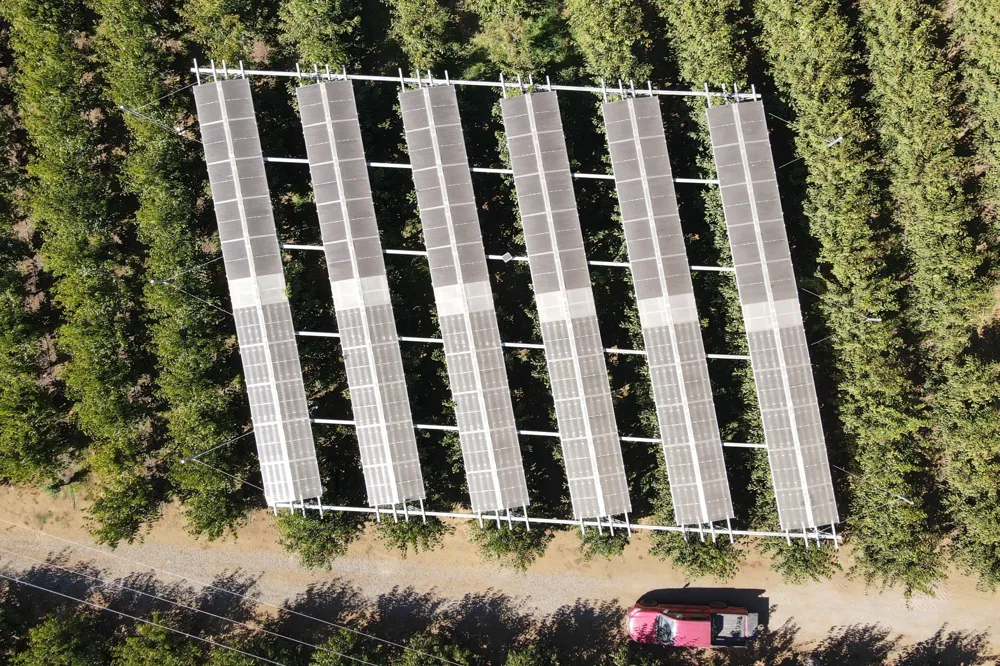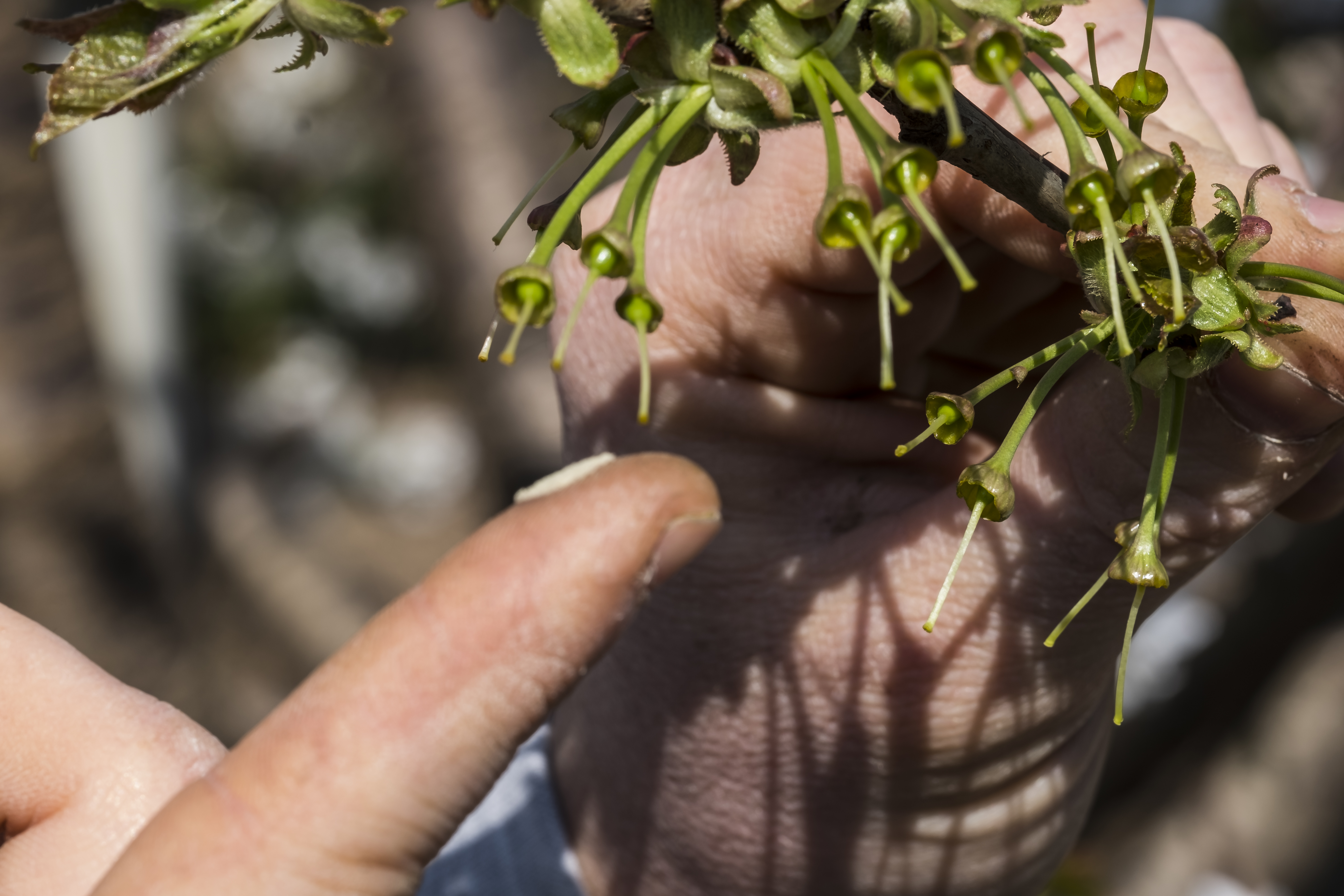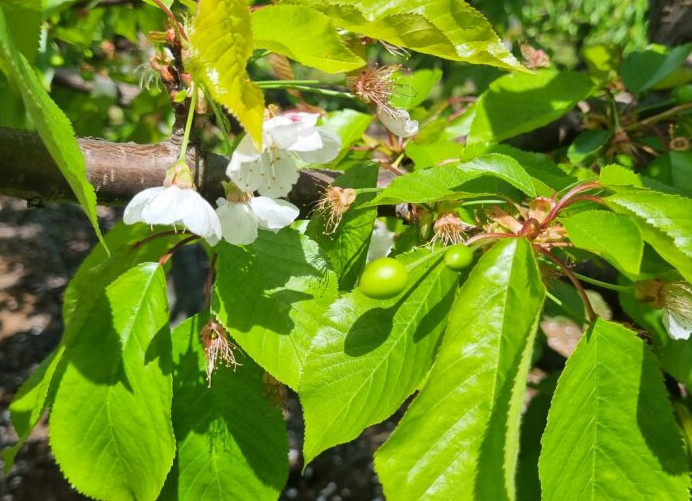The agriculture of the future
In a context of climate crisis and water scarcity, Chile is betting on innovation with a pioneering agro-photovoltaic project in South America.
Located in the Ñuble region, this system combines solar energy production with fruit farming, optimizing land use efficiency and reducing water consumption.
Initial results on cherry trees show improvements in fruit yield, shoot growth rates, leaf area, and chlorophyll content, reinforcing the potential of this technology to transform the agriculture of the future.
In a context of climate change affecting the agricultural sector worldwide, an innovative agro-photovoltaic project has emerged as an initiative providing a response to this challenge.
The initiative is located in Chillán (Ñuble Region), a city of about 200,000 inhabitants (located 400 kilometers south of the Chilean capital, Santiago de Chile), whose economic engine focuses on fruit production and the agri-food industry.
The agro-photovoltaic (APV) panel project aims to improve land use efficiency and promote sustainability in agriculture. It combines public policies, research, development, and innovation.
Collaboration and research
The initiative is led by the Adventist University of Chile (UNACH), the organization that implemented the photovoltaic panels in the orchards, the Ñuble Farmers Association, the Ñuble Regional Government (which supports the project), and the Chilean Agricultural Research Institute (INIA), the body responsible for studying the technical, physiological, and productive validation on cherry trees and strawberries.
Watch the Video
"This project promises to transform the way fruit crops are produced by combining solar energy production with fruit farming.
This unprecedented effort in Chile aims not only to reduce production costs and optimize water use, but also to offer a new source of income to farmers," explained Jorge Retamal Salgado, a researcher at INIA Quilamapu, who leads the eco-physiological research.
APV panels: a dual solution

Carlos González, president of the Ñuble Farmers Association, emphasized the importance of the initiative developed in Chile, describing it as a pioneering program that could mark a before and after in agriculture.
"If we manage to generate clean energy with these panels over the crops, not only will we reduce costs, but we will also protect the crops from rain and hail, which is essential in fruit production," he explained.
Why was the Ñuble region chosen for this project? For two reasons: the first is due to the water deficit; it is estimated that 66% of the territory, according to various studies, faces this issue.
Secondly, in the past 10 years, more than 50,000 hectares of agricultural land have been repurposed.
Promising results for cherry trees
Initial studies on cherry trees revealed promising data. For example, under APV panels, photosynthetically active radiation (PAR) transmission exceeded 60%, sufficient for this species to photosynthesize, reach the light saturation point for photosynthesis, and reduce solar shock on leaves and fruits.
It was also found that the presence of the panels reduced plant evaporation, generating greater moisture availability in the soil by up to 30% under APV crops, "which is essential in areas with limited water resources like the Ñuble region," explained Retamal.
Additionally, it was shown that with APV panels, cherry fruits displayed a significant improvement in quality and an increase in sugar levels, enhancing their sweetness and market appeal.
"This technology not only produces renewable energy, but also protects crops from direct sun exposure, improving fruit quality and optimizing key resources like water," stated researcher Jorge Retamal.
Greater efficiency
The benefits translate into using the same land for both agricultural production and energy generation, increasing land use efficiency by over 150%, according to preliminary results from the ongoing project.
"The panels reduce ambient temperature and water evaporation, increasing water availability for crops by over 20% and improving irrigation efficiency.
Additionally, APV panels act as a protective barrier against weather conditions (rain, heat, and hail), helping to reduce direct losses of fruits and flowers, while also reducing plant stress caused by excessive radiation and heat, improving overall plant health.
Since the coverings are made from glass panels instead of plastic, they prevent the release of microplastics into the environment — a major step toward more sustainable and less polluting agricultural practices, not only for the environment but also for the food chain," stated Retamal.
Comparison with traditional systems
In the previously described context, it’s important to note that, unlike conventional photovoltaic systems, these are a continuous system and do not allow crops to grow under the panels (they block direct light or photosynthetically active radiation).
In contrast, the technology implemented in this project partially solves the problem of competition for land use. "While traditional systems prioritize only electricity production, this innovation balances both agricultural production and energy generation, benefiting both sectors," says Carlos González.
Retamal estimates that this technology will be extended to other fruit trees with a light saturation point close to 1000 µmol m-2 s-1, such as apple trees, blueberries, raspberries, and possibly European hazelnuts.
Toward more efficient panels
Furthermore, he states that in his future research, semi-transparent photovoltaic panels should be improved to address the problems observed in his study, such as the low color of cherry fruits at harvest time.
"The goal is to use transparent panels with spectrally selective solar cells that are highly transparent at wavelengths between 400 and 700 micromoles (the range of wavelengths that is photosynthetically active for plants) and to use ultraviolet and/or infrared light to generate electricity (wavelengths that in excess can be harmful to plants and/or are not essential for photosynthesis)," emphasized the researcher.
This implementation of cutting-edge technology could only be achieved through collaboration with international institutions such as the Fraunhofer-Gesellschaft Institute, which is leading its development, explained the researcher.
Costs and future outlook
For Retamal, although APV panels are more expensive than traditional panels (30% to 40% more), it is necessary to develop more efficient, durable, and affordable crystals to extend this technology to a greater number of orchards in Chile.
Since the economic benefits of APV translate into energy savings and the potential to generate additional income by selling excess energy to the central electrical grid in Chile, the long-term idea is that the cost of this technology will decrease as more companies enter the market and these panels become validated.
"We need to talk more about these kinds of initiatives. If subsidies were extended, we could triple clean energy production in the agricultural sector and significantly reduce production costs," concluded Carlos González.
Conclusion
The APV project not only marks a milestone in Chile's agricultural and energy innovation but also positions the country as a reference point for sustainability.
By combining fruit farming with renewable energy, this initiative opens up new possibilities to tackle the challenges of climate change in a smart and profitable way.
The APV project, supported by the Ñuble Farmers Association and the Ñuble Regional Government, is in the research and validation phase by INIA Quilamapu and stems from the need to reduce the use of plastic materials in agriculture, especially those used to protect crops, as well as to facilitate the implementation and independence of new technologies in orchards, such as electromobility and AI.
A new alternative for the future
The use of semi-transparent photovoltaic panels (PVP) is proposed as an alternative to traditional plastic coverings, allowing greater efficiency in land use.
The innovation of the project lies in the fact that photovoltaic panels not only generate energy but also allow enough light to pass through for crops to develop properly — something traditional photovoltaic panels don’t allow due to their opacity.
Watch the Video
Source text and images: Pedro Andrés Soto Palma, Project Communications Manager, INIA Quilamapu, Chile
Cherry Times - All rights reserved











